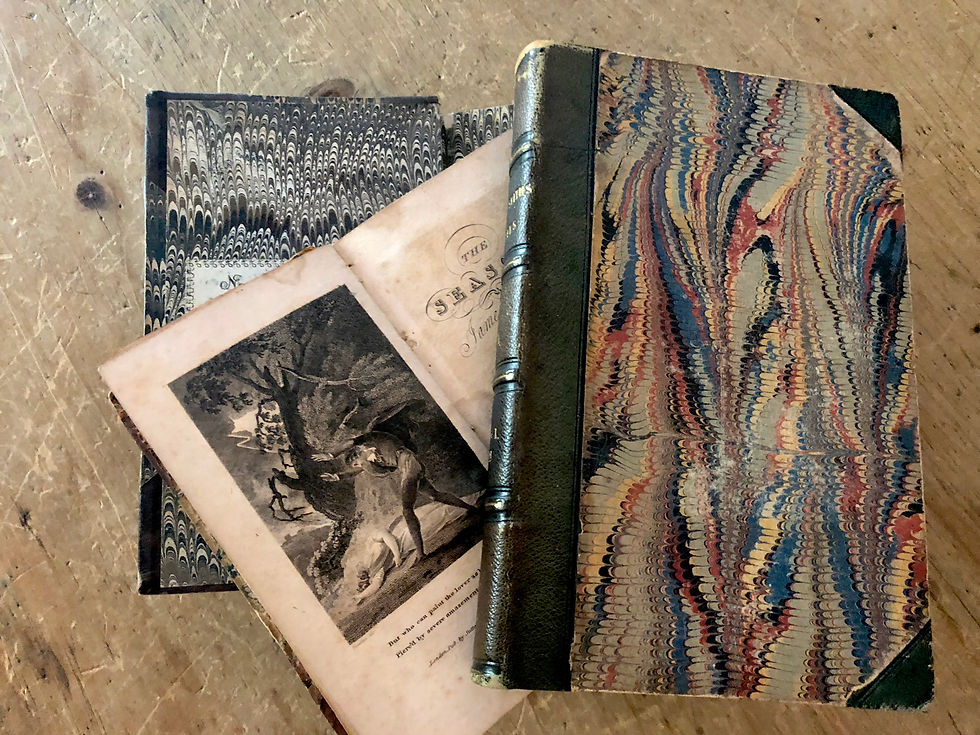
Old leather books are one of the best things to collect! If you have an American country antiques collection they are a must.
In addition to enhancing the appearance of your old cupboards and shelves, they are, in themselves, a fascinating category of items to collect.

How many of your country antiques can you say, with certainty, exactly how old they are? Even know the exact year, and where they were made? Not many!
Most early books tell you the date and place of publication, so you know exactly how old they are and where they came from.
Most rural households had very few books. Usually, they had a Bible, but that was their only book, in many cases. People wrote their names in the books because they were so precious. Sometimes a succession of owners wrote their names in the books. With a little research, it is often possible to identify exactly who owned the book, where they lived, even what they did for a living.
Old leather books can tell you much more that what's written on their pages!

Best of all, you can find good old leather books for under $100, sometimes, well under.
What to look for
Interesting shapes, titles, distinctive features
Look for bindings that are pleasing to the eye. Most are plain brown leather, but some have tooling, colored leather, marbleized covers, raised areas. What's important is that they look good in a group.
Bibles, Hymnals, Books of Psalms
Whether or not you are religious, early Bibles and other religious books were in every 19th century household, often as prized possessions, so having them is a key part of any country collection.
Often, the only book a household owned was a Bible. Birth and death records were sometimes recorded in it. Small ones were carried to church. Larger ones sat in special boxes at home to protect them. Since they were so precious, Bibles are where you can find the most information about the owners.
I bought a collection of old books a few years ago and among the books was a plain brown, unembellished 1824 leather Bible measuring about 7" x 5". Inside the front cover was written in ink: "Josiah Parks, Litchfield Conn" and on the next page, "Emma Parks, Litchfield Conn".
Since Litchfield is my home, a little research revealed that Josiah Parks ran the first stage coach service between Litchfield and Hartford in the 1820s.

At some point I will donate the book to the Litchfield Historical Society. What an exciting find!
The most collectible leather books are the small, fat ones. These were meant to be carried around in a pocket. Most sought after, and therefore, the most expensive are those marked "Watts" - books of Psalms compillated by Rev. Isaac Watts in the 1820s and 30s.

They can be very tiny - the one on the left is only 3 1/2" x 2". Finding them is hard, and they are usually over $100, but if you find one, grab it!

Once in a while you can come across a really teeny Bible - an inch or so in size. These are rare and were given as gifts or mementos, being quite impractical to read, especially in low light.
This one stands next to the Josiah Parks Bible. It measures only 2" x 1 3/4". It is actually a history of the Bible. I have seen only 3 in my travels and they tend to be very expensive.
Hymnals were also often made so that they could fit in a pocket to be taken to church. You can often find Methodist or Methodist Episcopal Hymnals in the same short, fat shape as the Watts books. These were printed from the 1820s through the 1890s. The earlier ones are expensive - $100 or more, but later ones can have interesting tooled bindings -and can be much cheaper - worth looking for!
Science, Literature and the Arts
Formal education in the early 1800s was for boys, not girls. It was a lucky girl who got an education beyond the basics of reading and writing at that time. Her learning focused on domestic skills, embroidery and painting.
The more academic studies were mostly reserved for boys. In urban centers academies of higher learning emerged for boys aged 12 and up. Academic studies of math, science, the law, politics and the arts were emphasized. Books on all these subjects were published in America, and many, especially literary works of English authors were imported from England.


Look for interesting subjects, attractive bindings, and published dates earlier than 1860. Marbelized covers and interior pages make a great contrast to plain leather books. Many of these books have illustrations. Buy what strikes your fancy. These books can often be found for under $50.
Once in a great while I have come across a leather book from the 1700s. This is very rare, indeed - often they are also very expensive.


I found this 1785 Connecticut book at a flea market for under $50, but that was a lucky find! My advice - when you see an old leather book, no matter how dull looking from the outside, look inside to see what treasures it stores!

Collecting early leather books is satisfying in a way that collecting other things is not. They provide instant warmth to a room, and you can spend hours and hours learning about all that they have to teach about their subject matter as well as their owners.
Carole Conn
